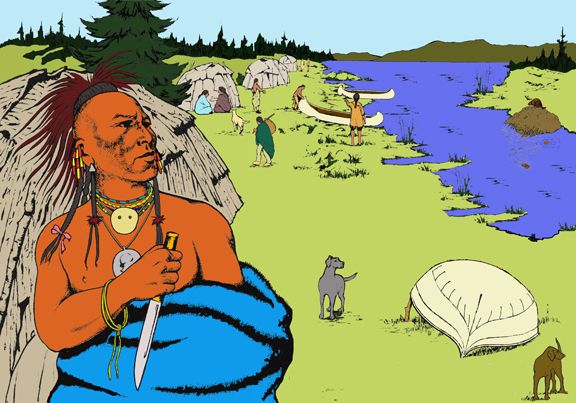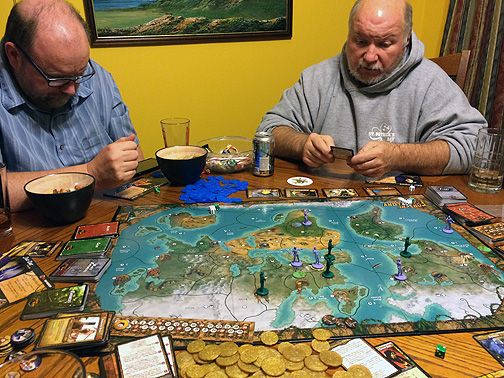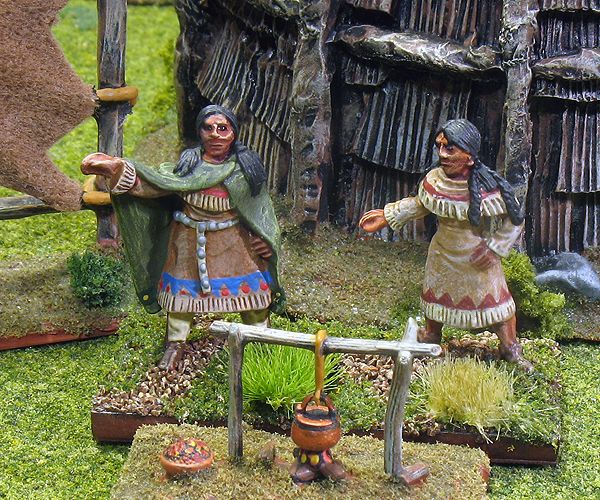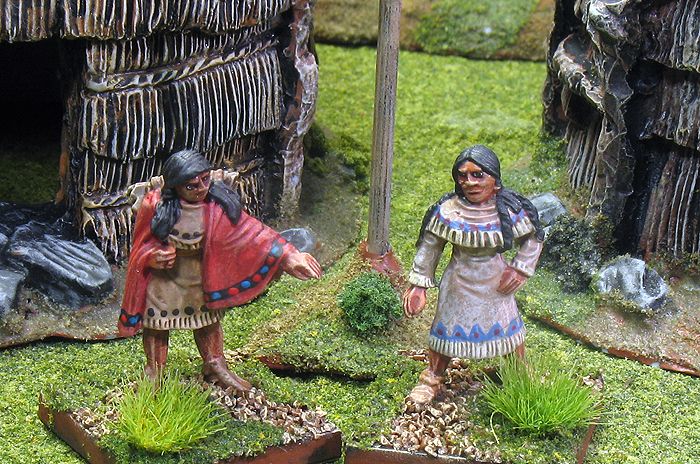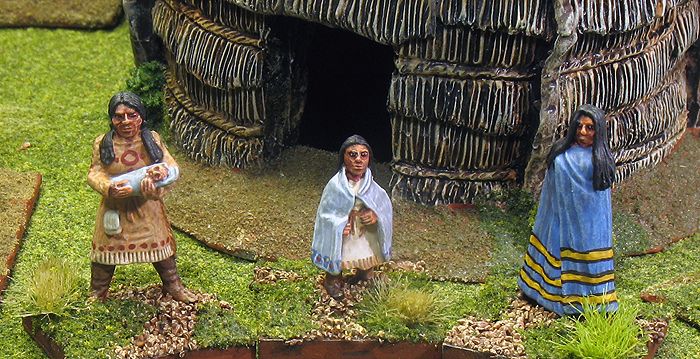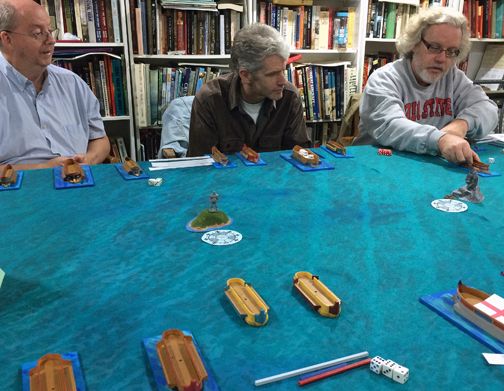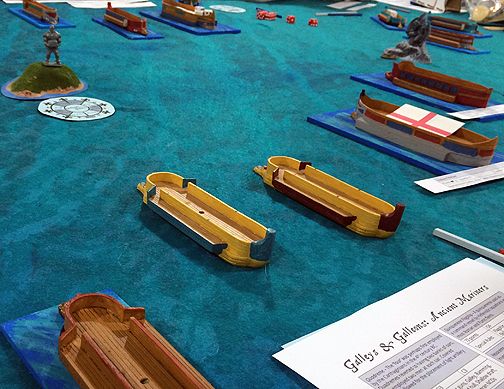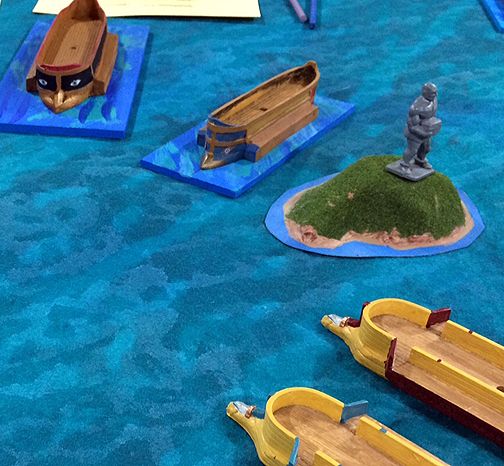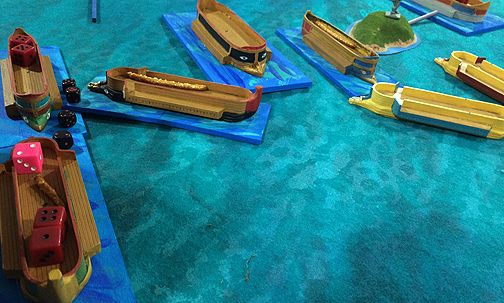It has been more months than I'd hoped, but the Beaver Wars in Ohio are being re-fought once more. The Beaver Wars were a series of conflicts fought in the late 1600s and early 1700s between Native American tribes over hunting and trapping lands. The campaign seeks to recreate that struggle in the Ohio Valley, the area of my home state. At the close of the first phase of our playtest, I'd re-tooled the rules to make them simpler. I also changed or eliminated the mechanics I didn't like, and worked to head off tendencies I was seeing that I saw would create trouble. I listened to playtester feedback and incorporated some new ideas.
 |
| Gaming The Beaver Wars at a pizza shop in Central Ohio -- where some of the action historically took place! |
The newer, simplifield Beaver Wars rules were sent out to my batch of playtesters (mostly new to get a wider variety feedback) to read over, and we started up an 8-player campaign the day after Christmas. This campaign would cover the earlier of the three phases of the Beaver Wars (the last one covered the middle phase). The tribes participating would be the Seneca and Mohawk from the Iroquois Confederacy, along with their traditional enemies the Erie and Susquehannock. The dubiously-named Neutral tribe would participate, along with Ohio native tribes the Miami, Shawnee, and Kickapoo.
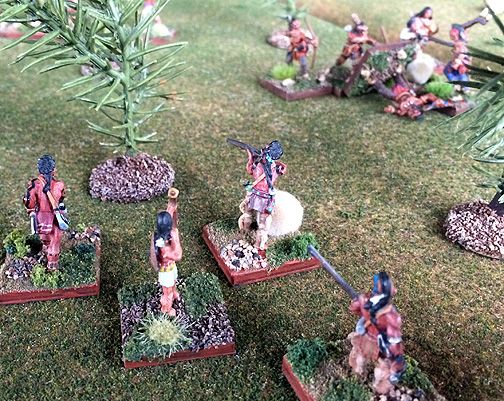 |
| My Erie tribesmen move up to attack the much better-led Mohawk hunters |
Strategic orders went by the wayside. No longer would players have to choose between "Invade," "Raid," etc., in this campaign. Instead, players have a series of cards that they play which characterize their actions between two poles. One extreme is almost total mobilization for war, while the other extreme is almost total dispersal to hunt and trap. This effects not only how many beaver pelts they obtain (one of the campaign objectives), but also the order that players select their tribe's opponent for this turn. The cards chosen by the opponents determine which chart they will roll on to see which scenario they will play in their battle. The Beaver Wars in Ohio campaign rules will contain 18 scenarios, complete with maps, terrain layout, special scenario rules, deployment, and scenario victory conditions. For those that are less interested in refighting this fascinating conflict, the scenarios will also hopefully provide a lure for purchase the set.
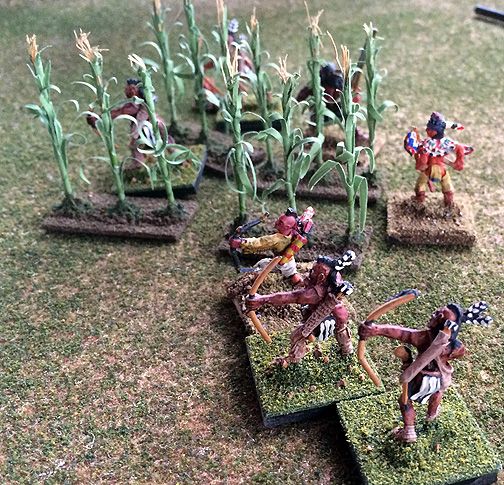 |
| Angry villagers from the Neutral tribe advance through the fields to stop the Shawnee horse thieves |
In my first turn, most of the tribes leaned towards the hunting and trapping end of the spectrum. The less aggressive stance means they obtain more beaver pelts as a result of the turn. This raises their level on a chart which determines how many figures on their battlefield roster may be armed with firearms as opposed to bow. All tribes receive pelts, but the difference between the tribe that chooses the most warlike stance and that the chooses the most hunting-focused actions is fairly significant. There are bonus to the player who chooses warpath, but I filed this observation away as possibly in need of tweaking.
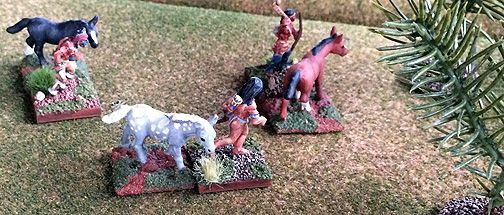 |
| Shawnee warriors and youths escape into the woods with their stolen horseflesh! |
The players produced four battles on turn one. That is another change from the first version of the campaign. Under these rules, every player who shows up fights a battle (unless there is an odd number, when the least aggressive becomes the odd-man-out). I didn't like how we would sometimes have 6 players show up, only to have two people fight battles and the other four relegated to watching, or playing something else. So, eight players meant eight battles.
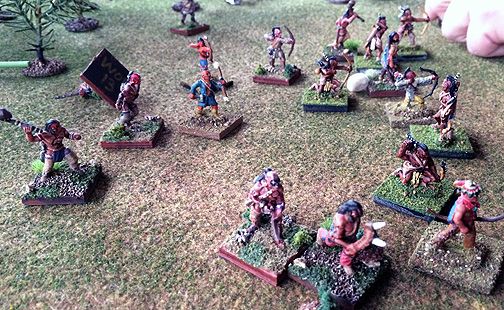 |
| A bloody running fight developed between rival Kickapoo and Miami hunting parties |
As insurance against players who had something come up and prevent them from attending, I am playing as the eight player, this time around. If I have an odd number, I will be the one who doesn't play -- not one of my players. This will probably disappoint the players if it happens, as I am renowned for my horrible dice rolling, making me an attractive target! Incidentally, we are meeting at a local pizza shop which has a side room available. We arrived the day after Christmas and moved the tables around to suit our needs. Not only do they have good food, making a tasty lunch a bonus, they have free soda refills.
 |
| Seneca raiders advance through Susquehannock cornfields intent on captives and scalps! |
My scenario that my Erie tribe rolled up was "Trapper's End." I had captured a Mohawk trapper and was holding him as bait to lure in the Mohawk trapping party. That was about all that worked in my plan. My dice rolling was true to form, and every time I closed with the enemy, my activation rolls would go south. Meanwhile, the Mohawk player was cautious, kept his forces together, and overwhelmed my unsupported attacks on his firing line he'd set up. I kept at him, though, and had a couple successes, but soon my forces dropped below half and we were running from the battlefield. I ended up with a Major Defeat, the Mohawk with the turn's only Major Victory.
 |
| A Seneca youth knocks out a Susquehannock woman in the fields...has the young man found his bride? |
Next to me, the Shawnee had sent a raiding party to steal horses from a Neutral village. Yes, there really was a tribe called the Neutrals in America (so-named for their not taking sides in the bitter fight between the Iroquois and Huron confederacies). Otherwise, they were every bit as aggressive as other Indian tribes. The Shawnee deploy in or near their enemy's corral, and quickly began shuttling horses towards the woods on the opposite corner of the board -- their objective being to exit there. Keith had a hard time marshaling his braves, who show up on board in small bits, but nevertheless advanced bravely into the village cornfields to contest this thievery. What followed was a close, hard-fought battle that actually ended up with both sides equal in Scenario Victory Points (SVPs). The tie-breaker that I came up with gave Joe and his Shawnee the Minor Victory, but both earned Prestige Points (PPs) for their battlefield valor and success.
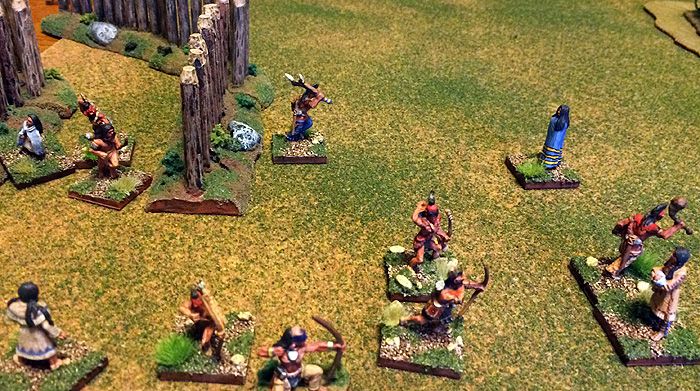 |
| Susquehannock women and children pound towards the gates and safety while their men boil out of the palisade entrance to defend them |
Our third battle saw a Kickapoo hunting party being pursued by a much larger Miami one. The Kickapoo goal is to run the gauntlet of a blocking force of Miami before overwhelming numbers show up behind them. I saw the least of this game, but I heard it was the most bloody of the turn. Both eschewed shooting and waded into hand-to-hand combat. The Miami warleader had to balance bringing up reinforcements with leading his men to engage and cut off the retreat path of his enemy. Once the Kickapoo fell below half strength, they scattered and soon ran off-table, giving the Miami a Minor Victory. The Kickapoo caused enough casualties to ensure the Miami remembered the engagement, though.
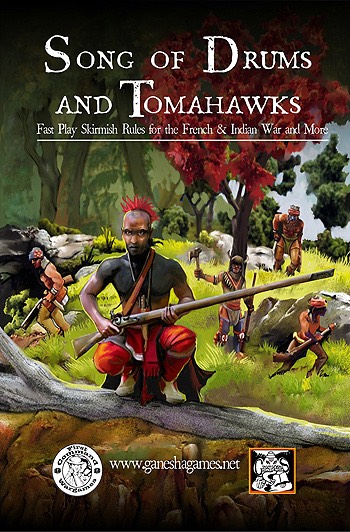 |
| The wargame rules we are using -- written by yours truly! |
The final battle was one of my favorite scenarios I'd written for the campaign: "Bring Them in Safely." The Seneca were raiding a Susquehannock village and surprise them, meaning that some of the tribe's women and children were still in the fields outside their stockade. Their goal is for them to scurry back through the entrance before being taken captive by the Seneca raiders. The Susquehannock defenders arrive in three batches over the first three turns, meaning they have to balance caution with boldness to save their women. Some of the Susquehannock women proved they needed no help, as one cut down a Seneca youth who sprinted ahead of the rest of his Iroquois brethren. The Seneca soon had more than half of the women and children in their clutches, but they proved hard to hold onto, and wriggled free more than once. Arrows flew and matchlocks boomed between the opposing forces, and a warriors fell. In the end, the Seneca held only two captives. A fatal shot by one of their warriors armed with a matchlock felled the Susquehannock leader, though. This caused the defenders to retreat back inside their stockade. The Seneca were content to carry home four scalps and two captives, and withdrew, as well.
Everyone enjoyed their battles, and I took notes on suggestions they made to scenarios and the rules. I made a couple minor tweaks immediately, but the bulk of what the players suggested were simply clarifications or suggestions to their scenarios. It is my intention that we should playtest each scenario 2-3 times over the course of the campaign. We are meeting again Jan. 23rd, so if you enjoyed this report, you can look forward to more tribal warfare beneath the forest canopy soon.
The rules we used are my own
Song of Drums and Tomahawks, which are available on both Ganesha Games' website and Wargame Vault. Links are below, if you're interested in picking them up. I hope to finish the playtest by summer, and make the campaign rules available then. They will also contain extensive historical information about the tribes and course of the actual historical conflict.
Mike Demana
www.firstcommandwargames.com
Links to buy Song of Drums and Tomahawks:









